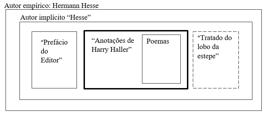Abstract
Given Hermann Hesse's eccentric position within German-language literature of the 20th century, almost as a retrograde “outsider”, the purpose of this article is try to situate Steppenwolf (1927) in the discussions about “literary modernity”. To this end, considerations will be made that demonstrate how the book represents a subject in the context of the modern world of the 1920s and how the novel adopts a multiperspectivity structure that reflects the new modes of representation that began to be explored in modern literary form. This structure will be analyzed based on the narratological categories proposed by Genette (1995), pointing out the three different perspectives on the protagonist Harry Haller present in the book: “Editor's Preface”, “Notes by Harry Haller” and the “Treatise on the Steppenwolf”. From the analysis, it will be discussed the possibility of understanding the events narrated in the “Notes” as fruits of the imagination or as the protagonist's autobiographical testimony. In the first case, the book falls into the category of realism, in the second, it belongs to fantastic literature. Finally, the different editions of the book - which have significant differences - will be compared in order to show how the first edition can favor the classification of the novel as fantastic.
Keywords:
Steppenwolf; modernity; fictional; factual; fantastic

 Thumbnail
Thumbnail
 Thumbnail
Thumbnail

